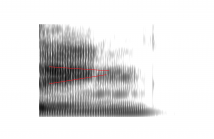
- Read more about The Perception of the English Alveolar-velar Nasal Coda Contrast by Monolingual versus Bilingual Chinese Speakers
- Log in to post comments
Relatively little research has addressed the role of L1 in the
perception of English speech contrasts by Chinese learners of
English as L3. The present study investigates the role of L1 in
the perception of the English alveolar-velar nasal coda contrast
(/n/ vs. /ŋ/) after the vowels /i ʌ æ/ by bilingual Changsha
Chinese speakers, whose L1 is Changsha Chinese and L2 is
Standard Mandarin. Changsha Chinese only permits an
alveolar nasal coda /n/, while Standard Mandarin permits both
final /n/ and /ŋ/. We examined whether or not monolingual
- Categories:
 20 Views
20 Views- Read more about Cross-corpus Speech Emotion Recognition Using Transfer Semi-supervised Discriminant Analysis
- Log in to post comments
tsda_peng.pdf
- Categories:
 2 Views
2 Views- Read more about Cross-corpus Speech Emotion Recognition Using Transfer Semi-supervised Discriminant Analysis
- Log in to post comments
tsda_peng.pdf
- Categories:
 7 Views
7 Views- Read more about Cantonese Spoken Word Retention by Speakers with and without Congenital Amusia: Implications from Phonological Similarity and Cognitive Load Effects
- Log in to post comments
Success in spoken word processing relies not only on accurate word recognition but also the veracity with which words are maintained in memory. However, research on word retention is still scarce, especially in tonal languages and phonologically impaired populations. To address these gaps, the present study administered an auditory order recall task to native Cantonese speakers with and without amusia. Stimuli intrinsic (segmental similarity, suprasegmental similarity, and lexicality) and extrinsic (cognitive load) factors were manipulated.
- Categories:
 2 Views
2 Views- Read more about THE RELATIONSHIP OF VOICE ONSET TIME AND VOICE OFFSET TIME TO PHYSICAL AGE
- Log in to post comments
In a speech signal, Voice Onset Time (VOT) is the period between
the release of a plosive and the onset of vocal cord vibrations in the
production of the following sound. Voice Offset Time (VOFT), on
the other hand, is the period between the end of a voiced sound and
the release of the following plosive. Traditionally, VOT has been
studied across multiple disciplines and has been related to many
factors that influence human speech production, including physical,
physiological and psychological characteristics of the speaker. The
- Categories:
 8 Views
8 ViewsPages
- « first
- ‹ previous
- 1
- 2
- 3